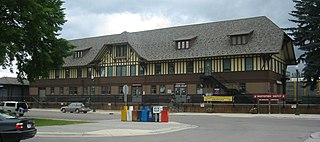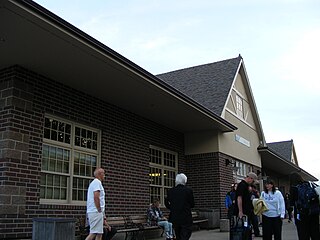
Havre is the county seat and largest city in Hill County, Montana, United States. Havre is nicknamed the crown jewel of the Hi-Line. It is said to be named after the city of Le Havre in France. As of the 2020 census the population was 9,362.

BNSF Railway is one of the largest freight railroads in North America. One of seven North American Class I railroads, BNSF has 35,000 employees, 32,500 miles (52,300 km) of track in 28 states, and nearly 8,000 locomotives. It has three transcontinental routes that provide rail connections between the western and eastern United States. BNSF trains traveled over 169 million miles in 2010, more than any other North American railroad.

The Empire Builder is an Amtrak long-distance passenger train that operates daily between Chicago and either Seattle or Portland via two sections west of Spokane. Introduced in 1929, it was the flagship passenger train of the Great Northern Railway and was retained by Amtrak when it took over intercity rail service in 1971.

The Flathead Tunnel is a 7-mile-long (11 km) railroad tunnel in the Rocky Mountains of northwest Montana near Trego, approximately 28 miles (45 km) west of Whitefish. Located on the BNSF Railway's Kootenai River Subdivision, it is the second-longest railroad tunnel in the United States after the Cascade Tunnel. It is ultimately named after the Bitterroot Salish, also known as the Flathead.

Havre station is a train station, re-fueling, and service stop for the Amtrak Empire Builder in Havre, Montana. The station, platform, and parking are owned by BNSF Railway, and the station was previously owned and operated by the Great Northern Railway

Whitefish station is a stop on Amtrak's Empire Builder in Whitefish, Montana. In addition to the Empire Builder, a once-daily Greyhound Lines bus service also links the station to Kalispell and Missoula. A car rental agency operates a window within the station. The station and parking lot are owned by the Stumptown Historical Society. BNSF Railway leases office space on the upper floors of the station and owns the platform and track.

The Northern Transcon, a route operated by the BNSF Railway, traverses the most northerly route of any railroad in the western United States. This route was originally part of the Chicago, Burlington and Quincy Railroad, Northern Pacific Railway, Great Northern Railway and Spokane, Portland and Seattle Railway systems, merged into the Burlington Northern Railroad system in 1970.

Winona station, formerly known as the Chicago. Milwaukee & St. Paul Railway Station, is a historic train station in Winona, Minnesota, United States. It is served by Amtrak's daily Empire Builder service. It was originally built in 1888 by the Chicago, Milwaukee, St. Paul and Pacific Railroad, known later as the Milwaukee Road. A former Milwaukee Road freight house also exists here.

Minot station is a train station in Minot, North Dakota served by Amtrak, the national railroad passenger system. The station is located at the site of the former Great Northern Railway station, adjacent to the Minot Public Library, and close to Minot's City Hall and Downtown Minot.

U.S. Highway 2 (US 2) is an east–west United States Numbered Highway in the state of Montana. It extends approximately 666.645 miles (1,072.861 km) from the Idaho state line east to the North Dakota state line.

The Southern Transcon is a main line of BNSF Railway comprising 11 subdivisions between Southern California and Chicago, Illinois. Completed in its current alignment in 1908 by the Atchison, Topeka and Santa Fe Railway, when it opened the Belen Cutoff in New Mexico and bypassed the steep grades of Raton Pass, it now serves as a mostly double-tracked intermodal corridor.
The Columbia River Subdivision or Columbia River Sub is a railway line running about 167 miles (269 km) from Wenatchee to Spokane, Washington. It is operated by BNSF Railway as part of their Northern Transcon. The original line was built as part of James J. Hill's Great Northern Railway transcontinental railway line.
The Scenic Subdivision or Scenic Sub is a railroad line running about 155 miles (249 km) from Seattle, Washington to Wenatchee, Washington. It is operated by BNSF Railway as part of their Northern Transcon. This route includes the Cascade Tunnel, as well as the 1893 site of the "last spike" near Scenic, Washington, which marked the completion for the Great Northern Railway transcontinental railway line built by James J. Hill.
The Morris Subdivision or Morris Sub is a railroad line that runs about 113 miles (182 km) from Breckenridge to Willmar, Minnesota. Currently operated by BNSF Railway, this was part of the Great Northern Railway's transcontinental line from Minneapolis to Seattle, Washington. Today, BNSF's Northern Transcon travels up the Staples Subdivision instead, which is a more direct route to Fargo, North Dakota.
The Moorhead Subdivision or Moorhead Sub is a railroad line which runs from Moorhead to Breckenridge, Minnesota. It briefly crosses the border into North Dakota around Wahpeton, across the Red River from Breckenridge. Currently operated by BNSF Railway, this was part of the Great Northern Railway's transcontinental line from Minneapolis to Seattle, Washington.

Streator Station was a train station located in Streator, Illinois, United States. It was served by numerous Atchison, Topeka and Santa Fe Railway (AT&SF) passenger trains during its heyday. Amtrak served the station until 1996 with the Southwest Chief between Chicago and Los Angeles daily. When the Burlington Northern and the AT&SF railways merged, BNSF built a connecting track between the two main lines east of Cameron, Illinois,. This allowed passenger trains to change from the former Chicago, Burlington and Quincy Railroad (CB&Q) main line to the Southern Transcon freely. This along with the amendment of a stretch of track that was essential for getting to Chicago Union Station forced Amtrak to reroute the Southwest Chief to bypass Chillicothe and Streator.
The Spokane Subdivision or Spokane Sub is a railway line running between Sandpoint, Idaho and Spokane, Washington. It forms a part of the Northern Transcon. The line has shared track rights with Union Pacific Railway. The Amtrak Empire Builder uses the line and stops in Sandpoint and Spokane.
The Chillicothe Subdivision or "Chillicothe Sub" is a railway line running about 229 miles (369 km) from Chicago, Illinois to Fort Madison, Iowa in the United States of America. It is operated by BNSF Railway as part of their Southern Transcon route from Chicago to Los Angeles. The Chillicothe Subdivision is a high volume route connecting three principal yards in Chicago in the east and the Marceline Subdivision in the west which continues to Kansas City.

The California Zephyr is a passenger train operated by Amtrak between Chicago and the San Francisco Bay Area, via Omaha, Denver, Salt Lake City, and Reno. At 2,438 miles (3,924 km), it is Amtrak's longest daily route, and second-longest overall after the Texas Eagle's triweekly continuation from San Antonio to Los Angeles, with travel time between the termini taking approximately 511⁄2 hours. Amtrak claims the route as one of its most scenic, with views of the upper Colorado River valley in the Rocky Mountains, and the Sierra Nevada. The modern train is the second iteration of a train named California Zephyr; the original train was privately operated and ran on a different route through Nevada and California.

On September 25, 2021, at approximately 3:55 p.m. Mountain Daylight Time, Amtrak passenger train 7/27, the westbound Empire Builder, carrying 141 passengers and 17 crew members, derailed west of the town of Joplin, Montana, United States. The train consisted of two locomotives and ten cars, eight of which derailed.













